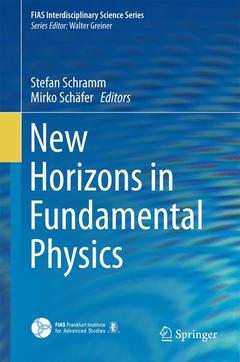New Horizons in Fundamental Physics, Softcover reprint of the original 1st ed. 2017 FIAS Interdisciplinary Science Series
Coordonnateurs : Schramm Stefan, Schäfer Mirko

This volume presents the state-of-the-art in selected topics across modern nuclear physics, covering fields of central importance to research and illustrating their connection to many different areas of physics.
It describes recent progress in the study of superheavy and exotic nuclei, which is pushing our knowledge to ever heavier elements and neutron-richer isotopes. Extending nuclear physics to systems that are many times denser than even the core of an atomic nucleus, one enters the realm of the physics of neutron stars and possibly quark stars, a topic that is intensively investigated with many ground-based and outer-space research missions as well as numerous theoretical works. By colliding two nuclei at very high ultra-relativistic energies one can create a fireball of extremely hot matter, reminiscent of the universe very shortly after the big bang, leading to a phase of melted hadrons and free quarks and gluons, the so-called quark-gluon plasma.
These studies tie up with effects of crucial importance in other fields. During the collision of heavy ions, electric fields of extreme strength are produced, potentially destabilizing the vacuum of the atomic physics system, subsequently leading to the decay of the vacuum state and the emission of positrons. In neutron stars the ultra-dense matter might support extremely high magnetic fields, far beyond anything that can be produced in the laboratory, significantly affecting the stellar properties.
At very high densities general relativity predicts the stellar collapse to a black hole. However, a number of current theoretical activities, modifying Einstein?s theory, point to possible alternative scenarios, where this collapse might be avoided.
These and related topics are addressed in this book in a series of highly readable chapters. In addition, the book includes fundamental analyses of the practicalities involved in transiting to an electricity supply mainly based on renewable energies, investigating this scenario less from an engineering and more from a physics point of view.
While the topics comprise a large scope of activities, the contributions also show an extensive overlap in the methodology and in the analytical and numerical tools involved in tackling these diverse research fields that are the forefront of modern science.
Part I Nuclear Structure and Superheavy Elements: Intertwining of Greiner's Theoretical Works and our Experimental Studies (J.H. Hamilton et al.).- Eighty years of research on super-heavy nuclei (S. Hofmann).- Perspectives of heavy and superheavy nuclei research (A.V. Karpov et al.).- Superheavy Element Chemistry - New experimental results challenge theoretical understanding (R. Eichler).- 25 Years of FRS Experiments and New Horizons (H. Geissel et al.).- SHE Research with Rare-Isotope Beams, Challenges and Perspectives, and the new Generation of SHE Factories (G. Münzenberg et al.).- Multi-modal Collinear Ternary Fission (W. von Oertzen et al.).- From the stable to the exotic: clustering in light nuclei (C. Beck).- Towards Laser Spectroscopy of Superheavy Elements (H. Backe).- Part II Physics of Heavy-Ion Collisions: Chemical freeze-out conditions in hadron resonance gas (V. Vovchenko et al.).- The QCD Phase Diagram and Hadron Formation in Relativistic Nuclear Collisions (F. Becattini et al.).- Degrees of Freedom of the Quark Gluon Plasma, tested by Heavy Mesons (H. Berrehrah et al.).- Electromagnetic emissivity of hot and dense matter (E.L. Bratkovskaya at al.).- Heavy-Ion Collisions: Status of Chemical Equilibrium (J. Cleymans).- Novel developments of HYDJET++ model for ultra-relativistic heavy-ion collisions (L. Bravina et al.).- Jet tomography in heavy-ion collisions-Challenges, Results, and Open Problems (B. Betz).- Part III QED - Strong Fields and High Precision: Probing QED Vacuum with Heavy Ions (J. Rafelski et al.).- Laser assisted Breit-Wheeler and Schwinger processes (T. Nousch et al.).- A method to measure vacuum birefringence at FCC-ee (U.I. Uggerhoj et al.).- Unifying Quantum Electro-Dynamics and Many-Body Perturbation Theory (I. Lindgren et al.).- Part IV Astrophysics: Simulations of accretion disks around massive stars (M. Algalán et al.).-Neutron Stars-Possibilities and Limits for Exotic Phases (S. Schramm et al.).- The Case for an Underground Neutrino Facility in South Africa (Z.Z. Vilakazia et al.).- Part IV Special topics: Covariant Hamiltonian representation of Noether's theorem and its application to SU(N) gauge theories (J. Struckmeier et al.).- Infrastructure Estimates for a Highly Renewable Global Electricity Grid (M. Dahl et al.).- Power flow tracing in complex networks (M. Schäfer et al.).- Patent protection of high-level research results (T. J. Bürvenich).
Prof. Dr. Stefan Schramm is teaching at the Institute of theoretical Physics at Frankfurt University and is member of the Frankfurt Institute of Advanced Studies (FIAS). His main research interests are: Models of Strongly Interacting Matter, Nuclear Astrophysics and Renewable Energies - Modeling the Grid. He is also co-author of the textbook Quantum Chromodynamics (Greiner, Schramm, Stein).
Mirko Schafer received his Diploma in physics from the University of Gießen in 2006. After a PhD in physics at the University of Frankfurt in 2011, he has been a Postdoctoral Researcher at the Department of Mathematics at Aarhus University and at the Frankfurt Institute for Advanced Studies. Since 2016 he is working as a Postdoctoral Fellow on complex networked systems and the system integration of renewable energy at the Department of Engineering at Aarhus University.
Presents advances across a broad range of topics in modern nuclear physics
Details recent progress in the study and generation of superheavy and exotic nuclei
Identifies methodology, analytical and numerical tools that could be used jointly in highly interdisciplinary fields
Includes supplementary material: sn.pub/extras
Date de parution : 11-2016
Ouvrage de 389 p.
15.5x23.5 cm
Thème de New Horizons in Fundamental Physics :
Mots-clés :
Superheavy Nuclei Physics; Exotic Nuclei Physics; Neutron rich Isotope; Neutron Star Nuclear Physics; Quark Star Nuclear Physics; Neutron Star Astrophysics; Relativistic Energy Nuclei; Quark Gluon Plasma; Ultra Dense Matter; Complex Energy Supply Grid; Analytical Numerical Tools Interdisciplinary



